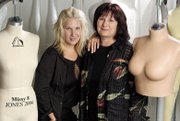Shapely Shadow: Fitting Garments at the Speed of Light
Malibu, Calif.–based Shapely Shadow Inc. is dispelling myths about technology and its relationship with fashion. The company is proving that technology is not impossible to understand and that it’s not just a man’s world.
Shapely Shadow, which markets 3-D dress forms and “fitting room” software, is entirely female-run. Ilona Foyer is president, and Roxy Starr, her daughter, serves as director of sales and marketing out of the company’s New York office.
Since 1997, Shapely Shadow has been producing symmetrical dress forms based on 3-D laser scans. Recently, it added Real Forms, made of a flesh-like silicon material. Its latest product, 360GV, is a software tool that allows apparel companies to view a finished sample on a virtual fit model and spin her around at the click of a mouse.
Having landed several high-profile customers— including American Eagle, DKNY, Victoria’s Secret and Chico’s—Shapely Shadow has gained word-of-mouth recognition that has helped it become an important industry player. The company emphasizes speed-to-market, and in the new quota-less world, that objective is taking on more importance.
“If you’re a manufacturer today, you’re most likely working with overseas partners, and speed-to-market is so important now. If you’re spending $350 an hour [on fit models and sample making] and can cut two hours in a day, that’s $700, and it adds up,” said Starr, who used that example based on the company’s case studies in a presentation before the American Apparel & Footwear Association.
Shapely Shadow’s 360GV kit also helps companies save time because it eliminates a lot of express mail, FedEx shipping of samples and e-mails. “Some of our clients do 17,000 fittings a year and send between 50,000 and 70,000 JPEG images back and forth with their vendors,” explained Foyer. Helping to reduce that process by up to 75 percent saves a bundle, she said.
The investment in 360GV is minimal, she added. Users are required to take digital images of a fit model from various angles on Shapely Shadow’s PiXi-M turntable. The images are converted to Java script or Quick- Time files and e-mailed to clients. “Instead of five or six different images, it comes in one style file,” Starr explained.
The recipient can then view the model from various angles and make any necessary alterations. Because the viewer is usually an overseas manufacturer, it is the next best thing to having a live model there, Starr added. “A lot of these factory representatives in Asia can’t imagine a model having such a big butt, but they see this and realize what they’re dealing with,” she said.
“There’s no way overseas manufacturers can fully understand the American body, and you’re most likely not able to send a fit model there,” Foyer added.
The customization associated with Shapely Shadow’s 3-D technology has caught the attention of other vendors. New York–based CAD company Optitex USA Inc. recently integrated Shapely Shadow’s technology into its own 3-D software to allow users to import live fit models created with 360GV into the Optitex system.
Starr explained that companies such as American Eagle are taking the technology to different levels, often using it for merchandising to replace computergenerated models with fit models created with 360GV.
Foyer and Starr expect 360GV to grow as more companies look to enhance margins through technology investments. The concept builds upon the company’s staple dressforms business, which allows fit models to be scanned by lasers in a light box. The image is converted into computerized data that is used to manufacture dress forms made from PVC (polyvinylchloride) or silicon.
The silicon forms are supple and almost lifelike, Starr said, noting that they are more conducive than PVC forms for innerwear and swimwear companies.
“You can take an underwire bra, for example, and fit it on the form to see how much pressure and what an impact it makes,” Starr explained. “It can leave an impression, and obviously in a lifelike situation, it would probably dig into the skin.”
The company got its start providing dress forms to Hollywood costume designers who needed a good way to fit high-profile actors, who could not afford to sit for hours during fitting sessions. The laser technology is accurate up to 1/8 inch, according to Foyer. Speedo is now using that same technology to construct super-fast swimsuits for the company’s Olympic endorsers.
Starr and Foyer see additional opportunities for new products down the road. And though they have seen new competition enter the market, they expect to remain at the forefront. “Any place where we can help improve speed-to-market is an area we want to take advantage of,” Starr said.






















